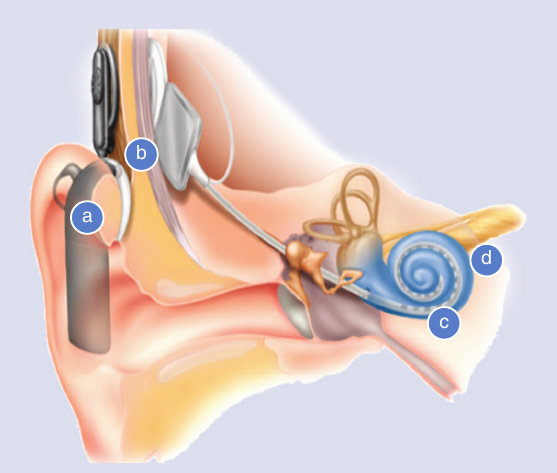Engineering Challenges in Cochlear Implants
By Tam Nguyen, Steven Zupancic, and Donald Y.C. Lie
NOTE: This is an overview of the entire article, which appeared in the Fourth Quarter 2012 issue of the IEEE Circuits and Systems Magazine.
Click here to read the entire article.
Cochlear Implants (CIs) have a long history of development and deployment, as the authors point out. After a brief discussion of past developments, the article presents an overview of the anatomy and physiology of the cochlea and the implications for CIs. One important concept is the spectral analysis of incoming sound that is performed by the physical characteristics of the Basilar Membrane, which extends the length of the cochlea. While current CI implementations seek to mimic this function, they discard much of the temporal analysis that the mammalian cochlea performs, according to the authors.
Current CIs include both external and internal (implanted) parts. In the external circuitry, sound is converted to electrical signals (via a microphone) and the resulting signal is processed, usually with the aim of optimizing the understanding of speech. The processed signal is then sent to the implanted device via an RF transmitter, which is placed next to the head.

Graphical depiction of the cochlear implant system: (a) speech processor, (b) cochlear implant, (c) electrode array, and (d) cochlea. (Photos courtesy of Cochlear Americas, © 2009 Cochlear Americas.)
The internal components include a receiver/stimulator (positioned in close proximity to the (external) RF transmitter, and a linear electrode array. The electrodes are surgically inserted into one of the chambers on the cochlea.
The processing which takes place in the external circuitry involves a parallel band-pass filter array. This creates multiple signal channels, each centered on a particular sound frequency. This is in approximate analogy to the spectral analysis performed by the Basilar Membrane in the natural ear.
Early implant filters used a Compressed Audio technique, where signals received from the microphone were frequency filtered and then gain-contorolled, to match the dynamic range of the auditory nerves. However, significant interference between adjacent electrodes was experienced when this technique was used. This article explains the Continuous Interleaved Sampling (CIS) technique that is now used to circumvent the problem.
The authors report on developments in noise reduction, number of channels used, and power/heat considerations in CI design. Advances in surgical techniques, speech processing technology, and microphone arrangements are addressed and evaluated.
ABOUT THE AUTHORS
NOTE: Photos and more complete bios of the authors are found in the article.
Tam Nguyen, M.D., M.S.E.E. (S’86), is currently an Assistant Professor of Otolaryngology, Head and Neck Surgery and an Adjunct Assistant Professor Speech and Hearing Sciences at Texas Tech University Health Sciences Center (TTUHSC), Lubbock, Texas. He is currently pursuing a Ph.D. degree with the Department of Electrical and Computer Engineering at Texas Tech University (TTU), Lubbock, Texas. His clinical interests are in cochlear implantation and head and neck surgery. His Ph.D. research interests include RF system-on-a-chip (SOC) and sensors applications in biomedical engineering, especially those related to hearing and balance disorders.
Steven Zupancic, Au.D., Ph.D., CCC/A, FAAA, is currently an Assistant Professor (Audiology) in the Speech, Language and Hearing Sciences Department and an Adjunct Assistant Professor in the Department of Surgery (Division of Otolaryngology) at Texas Tech University Health Sciences Center (TTUHSC), Lubbock, Texas. In addition is graduate faculty at the Texas Tech University College of Education Department of Educational Leadership. His research and clinical interests include balance/vestibular function assessment and management, and cochlear implantation.
Donald Y.C. Lie (S’86 – M’87 – SM’00) received the M.S. and Ph.D. degrees in electrical engineering (minor in applied physics) from the California Institute of Technology, Pasadena, in 1990 and 1995, respectively. He has held technical and managerial positions at companies such as Rockwell International, Silicon-Wave/ RFMD, IBM, Microtune Inc., SYS Technologies, and Dynamic Research Corporation (DRC). He is currently the Keh-Shew Lu Regents Chair Professor in the Department of Electrical and Computer Engineering, Texas Tech University, Lubbock, and also an Adjunct Professor in the Department of Surgery, Texas Tech University Health Sciences Center (TTUHSC). His research interests are: low- power RF/Analog integrated circuits and System-on-a- Chip (SoC) design and testing, and interdisciplinary research on medical electronics, biosensors and biosignal processing.






